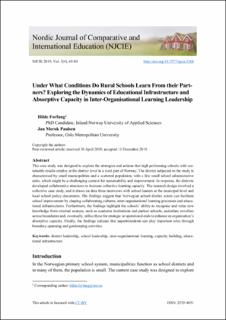| dc.contributor.author | Forfang, Hilde | |
| dc.contributor.author | Paulsen, Jan Merok | |
| dc.date.accessioned | 2020-04-02T07:29:51Z | |
| dc.date.available | 2020-04-02T07:29:51Z | |
| dc.date.created | 2019-12-26T08:49:41Z | |
| dc.date.issued | 2019 | |
| dc.identifier.citation | Nordic Journal of Comparative and International Education (NJCIE). 2019, 3 (4), 65-81. | en_US |
| dc.identifier.issn | 2535-4051 | |
| dc.identifier.uri | https://hdl.handle.net/11250/2649998 | |
| dc.description | This journal is distributed under the terms of the Creative Commons Attribution 4.0 International License (http://creativecommons.org/licenses/by/4.0/), which permits any use, duplication, adaptation, distribution and reproduction in any medium or format, as long as you give appropriate credit to the original author(s) and the source, provide a link to the Creative Commons license and indicate if changes were made. | en_US |
| dc.description.abstract | This case study was designed to explore the strategies and actions that high performing schools with sus-tainable results employ at the district level in arural part of Norway. The district subjected to the study is characterisedby small municipalities and a scattered population, with a few small school administrative units, which might be a challenging context for sustainability and improvement. In response, the districts developed collaborative structures to increase collective learning capacity. The research design involved a collective case study, and it draws on data from interviews with school leaders at the municipal level and local school policy documents. The findings suggest that Norwegian school district actorscan facilitate school improvement by shaping collaborating cultures, inter-organisationallearning processes and educa-tional infrastructures. Furthermore, the findings highlight the schools’ ability to recogniseand value new knowledge from external sources, such as academic institutions and partner schools, assimilate novelties across boundaries and,eventually,utilise thesefor strategic or operational endstoenhance an organisation’s absorptive capacity. Finally, the findings indicate that superintendents can play important roles through boundary-spanning and gatekeeping activities. | en_US |
| dc.language.iso | eng | en_US |
| dc.publisher | OsloMet - Storbyuniversitetet | en_US |
| dc.rights | Navngivelse 4.0 Internasjonal | * |
| dc.rights.uri | http://creativecommons.org/licenses/by/4.0/deed.no | * |
| dc.title | Under What Conditions Do Rural Schools Learn From their Partners? Exploring the Dynamics of Educational Infrastructure and Absorptive Capacity in Inter-Organisational Learning Leadership | en_US |
| dc.type | Peer reviewed | en_US |
| dc.type | Journal article | en_US |
| dc.description.version | publishedVersion | en_US |
| dc.source.pagenumber | 65-81 | en_US |
| dc.source.volume | 3 | en_US |
| dc.source.journal | Nordic Journal of Comparative and International Education (NJCIE) | en_US |
| dc.source.issue | 4 | en_US |
| dc.identifier.doi | 10.7577/njcie.3368 | |
| dc.identifier.cristin | 1763877 | |
| cristin.ispublished | true | |
| cristin.fulltext | original | |
| cristin.qualitycode | 1 | |

